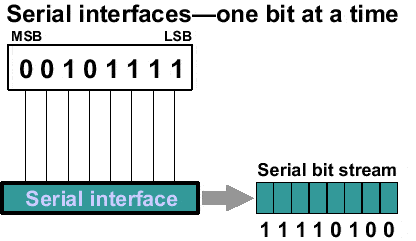Serial Transmission is a form of signal transmission that sends information one bit at a time over a single data channel. Serial interfaces are generally used to connect data communications equipment (DCE) such as modems to data terminal equipment (DTE) such as computers and terminals and for connecting a DCE to a DTE. The term “interface” indicates that these specifications describe how to establish an electrical (pinning) and mechanical (connector) shared boundary between devices.

An interface specifies a series of protocols, an arrangement of pins, special control signals, and other functions that enable devices to communicate with each other.
The common specifications for serial interfaces include the following:
- RS-232: The most commonly used serial interface in ordinary network communication, which supports transmission over a range of 0 to 20 Kbps at distances of up to 50 feet (15.24 meters). RS-232 can use either DB9 or DB25 connectors.
- RS-422: Specifies a balanced electrical interface but no specific mechanical interface for point-to-point serial communication. RS-422 typically uses either DB9 or DB37 connectors.
- RS-423: Similar to RS-422, except that unbalanced lines are used instead of balanced ones.
- RS-449: Specifies the mechanical interface for RS-422 and RS-423 and is used with these interfaces for high-speed serial communication with Channel Service Unit/Data Service Units (CSU/DSUs) and routers.
- RS-485: Defines a balanced, multipoint interface using tristate drivers to reduce noise. The combined interface RS-422/485 allows you to daisy-chain up to 31 serial devices to a single serial port and is typically used for interfacing industrial sensors and measuring equipment to a computer.
- RS-530: A successor to RS-232 and RS-449 that provides high-speed synchronous and asynchronous serial communication of up to 2 Mbps.
- V.35: An International Telecommunication Union (ITU) standard for data transmission at 48 Kbps that is typically used for connecting CSU/DSUs and routers for wide area network (WAN) communication over digital data service (DDS) lines. V.35 uses a block-shaped 34-pin connector.
- X.21: An ITU standard for synchronous communication between DTEs and DCEs on public X.25 packet-switched networks. X.21 typically uses a DB15 connector.
RS-232
Serial interfaces such as RS-232 are the most commonly used protocol for devices called line drivers, which enable terminals and hosts to be connected over phone lines and extend the distance over which the serial interface can function by regenerating the signal.
Related terminology includes
- Serial cable: A cable used to connect pieces of DCE to pieces of DTE by using a serial interface
- Serial port: A plug or connector on pieces of DTE that can use serial transmission to send and receive data